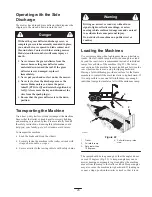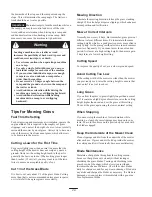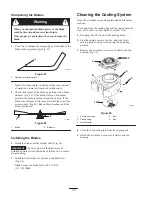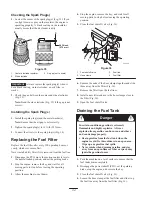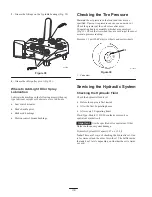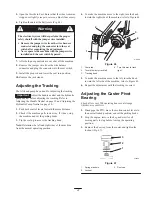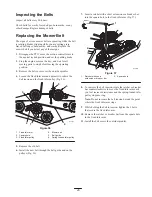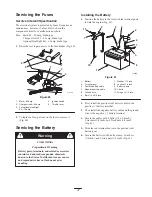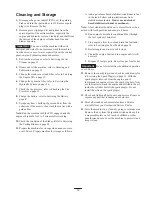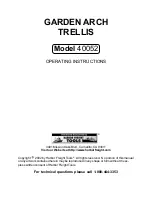
38
4. Apply a thin coat hydro fluid to the rubber gasket on the
replacement filter (Fig. 42).
m–1256
1
2
3
Figure 42
1.
Hydraulic filter
2.
Gasket
3.
Adapter
5. Install the replacement hydraulic filter onto the filter
adapter, but do not tighten.
6. Fill the hydraulic tank with hydraulic fluid until the
fluid overflows the filter
7. Turn the oil filter clockwise until the rubber gasket
contacts the filter adapter, then tighten the filter an
additional 1/2 turn (Fig. 42).
8. Clean up any spilled fluid.
9. Add fluid to the cold level of the baffle in the hydraulic
tank.
10. Start the engine and let it run for about 2 minutes to
purge air from the system. Stop the engine and check
for leaks.
Note: If one or both wheels will not drive, refer
Bleeding Hydraulic System on page 38.
11. Check the fluid level while the fluid is warm.
Note: The fluid should be between cold and hot.
12. If required, add fluid to the hydraulic tank. Do not
overfill.
Bleeding the Hydraulic System
The traction system is self bleeding; however, it may be
necessary to bleed the system if the fluid is changed or after
work is performed on the system.
1. Raise the rear of the machine so that the wheels are off
the ground and support it with jack stands.
2. Start the engine and run at low idle speed.
3. Engage the lever and traction on one side and spin the
wheel by hand.
4. When the wheel begins to spin on its own, keep it
engaged until wheel drives smoothly. (minimum
2 minutes)
5. Check hydraulic fluid level and add fluid as required to
maintain the proper level.
6. Repeat this procedure on the opposite wheel.
Hydraulic fluid escaping under pressure can
penetrate skin and cause injury.
•
If hydraulic fluid is injected into the skin it must
be surgically removed within a few hours by a
doctor familiar with this type of injury;
otherwise, gangrene may result.
•
Keep your body and hands away from pin hole
leaks or nozzles that eject high pressure
hydraulic fluid.
•
Use cardboard or paper to find hydraulic leaks.
•
Safely relieve all pressure in the hydraulic
system before performing any work on the
hydraulic system.
•
Ensure that all hydraulic fluid hoses and lines
are in good condition and all hydraulic
connections and fittings are tight before
applying pressure to hydraulic system.
Warning
Checking the Hydraulic Lines
After every 100 operating hours, check the hydraulic lines
and hoses for leaks, loose fittings, kinked lines, loose
mounting supports, wear, weather, and chemical
deterioration. Make necessary repairs before operating.
Note: Keep areas around the hydraulic system clean from
grass and debris buildup.
Waste Disposal
Engine oil, hydraulic oil, and engine coolant are pollutants
to the environment. Dispose of these according to your
state and local regulations.


